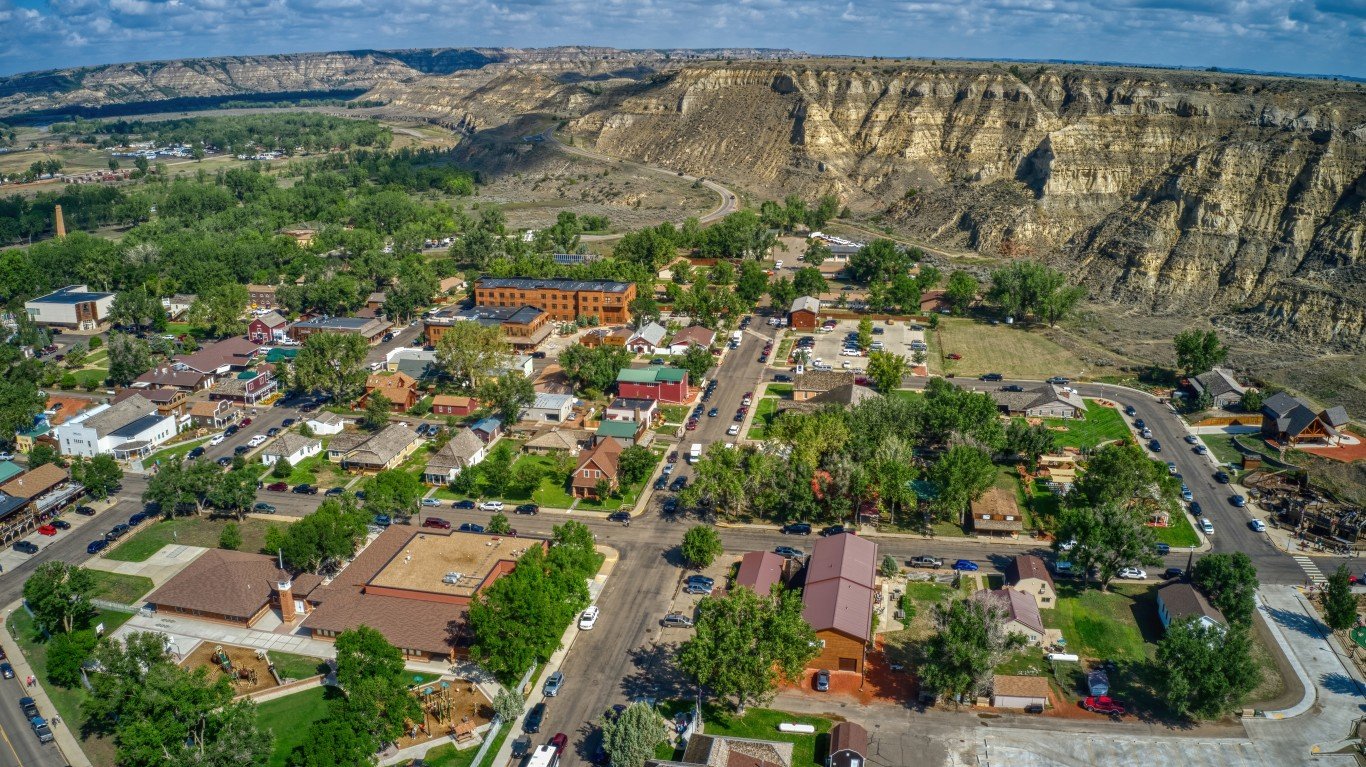

Obesity is an epidemic in the U.S. The condition has even been described as a leading cause of preventable death in the country because certain obesity-related illnesses such as heart disease and some cancers are killing as many as 500,000 people every year in America – and obesity is also a major risk factor for COVID-based mortality. In addition, obesity is a leading risk factor for Type 2 diabetes.
Using data from the Centers for Disease Control and Prevention, 24/7 Tempo has identified the most obese states in the country. States are ranked by the share of its adult residents who are considered obese, from the smallest to the largest percentage. Data on obesity – based on the number of adults 20 years and older with a body mass index of 30 and above – is self-reported and comes from the 2021 Behavioral Risk Factor Surveillance System.
The states with the highest obesity rates are concentrated in the South, while those with the lowest are in the West and Northeast. At least 35% of adults in some 19 states are obese, which is double the number of states with that rate in 2018, and up from 16 states in 2021, according to the CDC.
One perhaps surprising factor that influences obesity is Insufficient sleep – defined as sleeping less than seven hours per night on average. Sleep deprivation messes with the two hormones that control appetite – ghrelin, which tells you you’re hungry, and leptin, which tells you you’re full. Seven of the 19 states with the highest obesity rates report a higher incidence of insufficient sleep than the country as a whole. (These, on the other hand, are the states where people are getting the most sleep.)
With obesity rates rising in the U.S. over the last few decades to epidemic levels, misconceptions about the condition have spread, too. Here are the 16 most stubborn myths about obesity that need to go away.
Click here to see the most obese states in America
Methodology
To determine the most obese state, 24/7 Tempo reviewed data on obesity from the Centers for Disease Control and Prevention. States were ranked based on the prevalence of self-reported obesity among adults 20 years and older – with obesity being defined as having a body mass index of 30.0 and above – in the 2021 Behavioral Risk Factor Surveillance System. Supplemental data on the percentage of adults 18 and over who report no leisure time activity (including exercise) in 2019, the percentage of adults 20 and above with diagnosed diabetes in 2019, and the percentage of adults 18 and over who report fewer than seven hours of sleep on average in 2018 came from the 2022 County Health Rankings & Roadmaps program of the University of Wisconsin Population Health Institute.

50. Hawaii
> Pct. adults aged 20 and older with BMI ≥ 30.0 (2021): 25.0%
> Pct. adults aged 18 and older who don’t exercise (2019): 23.9% (16th lowest)
> Pct. adults aged 20 and older with diabetes (2019): 9.3% (23rd lowest)
> Pct. adults aged 18 and older with insufficient sleep (2018): 43.2% (the highest)
[in-text-ad]

49. Colorado
> Pct. adults aged 20 and older with BMI ≥ 30.0 (2021): 25.1%
> Pct. adults aged 18 and older who don’t exercise (2019): 18.7% (3rd lowest)
> Pct. adults aged 20 and older with diabetes (2019): 6.6% (2nd lowest)
> Pct. adults aged 18 and older with insufficient sleep (2018): 30.0% (2nd lowest)

48. Massachusetts
> Pct. adults aged 20 and older with BMI ≥ 30.0 (2021): 27.4%
> Pct. adults aged 18 and older who don’t exercise (2019): 26.0% (23rd highest)
> Pct. adults aged 20 and older with diabetes (2019): 7.4% (7th lowest)
> Pct. adults aged 18 and older with insufficient sleep (2018): 34.3% (20th lowest)

47. California
> Pct. adults aged 20 and older with BMI ≥ 30.0 (2021): 27.6%
> Pct. adults aged 18 and older who don’t exercise (2019): 22.3% (10th lowest)
> Pct. adults aged 20 and older with diabetes (2019): 9.4% (25th highest)
> Pct. adults aged 18 and older with insufficient sleep (2018): 34.5% (22nd lowest)
[in-text-ad-2]

46. New Jersey
> Pct. adults aged 20 and older with BMI ≥ 30.0 (2021): 28.2%
> Pct. adults aged 18 and older who don’t exercise (2019): 27.9% (14th highest)
> Pct. adults aged 20 and older with diabetes (2019): 9.5% (23rd highest)
> Pct. adults aged 18 and older with insufficient sleep (2018): 37.5% (17th highest)

45. Florida
> Pct. adults aged 20 and older with BMI ≥ 30.0 (2021): 28.4%
> Pct. adults aged 18 and older who don’t exercise (2019): 25.9% (25th highest)
> Pct. adults aged 20 and older with diabetes (2019): 9.4% (25th highest)
> Pct. adults aged 18 and older with insufficient sleep (2018): 37.3% (19th highest)
[in-text-ad]

44. Washington
> Pct. adults aged 20 and older with BMI ≥ 30.0 (2021): 28.8%
> Pct. adults aged 18 and older who don’t exercise (2019): 18.9% (4th lowest)
> Pct. adults aged 20 and older with diabetes (2019): 8.5% (14th lowest)
> Pct. adults aged 18 and older with insufficient sleep (2018): 31.8% (7th lowest)

43. Vermont
> Pct. adults aged 20 and older with BMI ≥ 30.0 (2021): 29.0%
> Pct. adults aged 18 and older who don’t exercise (2019): 19.3% (5th lowest)
> Pct. adults aged 20 and older with diabetes (2019): 7.3% (5th lowest)
> Pct. adults aged 18 and older with insufficient sleep (2018): 30.1% (4th lowest)

42. New York
> Pct. adults aged 20 and older with BMI ≥ 30.0 (2021): 29.1%
> Pct. adults aged 18 and older who don’t exercise (2019): 27.0% (18th highest)
> Pct. adults aged 20 and older with diabetes (2019): 9.4% (25th highest)
> Pct. adults aged 18 and older with insufficient sleep (2018): 38.9% (8th highest)
[in-text-ad-2]

41. Rhode Island
> Pct. adults aged 20 and older with BMI ≥ 30.0 (2021): 30.1%
> Pct. adults aged 18 and older who don’t exercise (2019): 26.0% (23rd highest)
> Pct. adults aged 20 and older with diabetes (2019): 9.1% (19th lowest)
> Pct. adults aged 18 and older with insufficient sleep (2018): 36.7% (22nd highest)

40. Oregon
> Pct. adults aged 20 and older with BMI ≥ 30.0 (2021): 30.4%
> Pct. adults aged 18 and older who don’t exercise (2019): 23.5% (14th lowest)
> Pct. adults aged 20 and older with diabetes (2019): 7.5% (8th lowest)
> Pct. adults aged 18 and older with insufficient sleep (2018): 32.8% (11th lowest)
[in-text-ad]

39. Connecticut
> Pct. adults aged 20 and older with BMI ≥ 30.0 (2021): 30.4%
> Pct. adults aged 18 and older who don’t exercise (2019): 23.3% (13th lowest)
> Pct. adults aged 20 and older with diabetes (2019): 8.2% (12th lowest)
> Pct. adults aged 18 and older with insufficient sleep (2018): 33.8% (18th lowest)

38. New Hampshire
> Pct. adults aged 20 and older with BMI ≥ 30.0 (2021): 30.6%
> Pct. adults aged 18 and older who don’t exercise (2019): 21.1% (7th lowest)
> Pct. adults aged 20 and older with diabetes (2019): 8.0% (10th lowest)
> Pct. adults aged 18 and older with insufficient sleep (2018): 35.3% (25th highest)

37. Utah
> Pct. adults aged 20 and older with BMI ≥ 30.0 (2021): 30.9%
> Pct. adults aged 18 and older who don’t exercise (2019): 18.7% (3rd lowest)
> Pct. adults aged 20 and older with diabetes (2019): 8.3% (13th lowest)
> Pct. adults aged 18 and older with insufficient sleep (2018): 31.2% (6th lowest)
[in-text-ad-2]

36. Nevada
> Pct. adults aged 20 and older with BMI ≥ 30.0 (2021): 31.3%
> Pct. adults aged 18 and older who don’t exercise (2019): 25.6% (24th lowest)
> Pct. adults aged 20 and older with diabetes (2019): 9.9% (18th highest)
> Pct. adults aged 18 and older with insufficient sleep (2018): 37.3% (20th highest)

35. Arizona
> Pct. adults aged 20 and older with BMI ≥ 30.0 (2021): 31.3%
> Pct. adults aged 18 and older who don’t exercise (2019): 23.6% (15th lowest)
> Pct. adults aged 20 and older with diabetes (2019): 9.8% (19th highest)
> Pct. adults aged 18 and older with insufficient sleep (2018): 34.9% (24th lowest)
[in-text-ad]

34. Idaho
> Pct. adults aged 20 and older with BMI ≥ 30.0 (2021): 31.6%
> Pct. adults aged 18 and older who don’t exercise (2019): 23.3% (13th lowest)
> Pct. adults aged 20 and older with diabetes (2019): 9.2% (21st lowest)
> Pct. adults aged 18 and older with insufficient sleep (2018): 33.4% (15th lowest)

33. Montana
> Pct. adults aged 20 and older with BMI ≥ 30.0 (2021): 31.8%
> Pct. adults aged 18 and older who don’t exercise (2019): 18.6% (the lowest)
> Pct. adults aged 20 and older with diabetes (2019): 6.4% (the lowest)
> Pct. adults aged 18 and older with insufficient sleep (2018): 30.9% (5th lowest)

32. Maine
> Pct. adults aged 20 and older with BMI ≥ 30.0 (2021): 31.9%
> Pct. adults aged 18 and older who don’t exercise (2019): 29.5% (9th highest)
> Pct. adults aged 20 and older with diabetes (2019): 8.7% (15th lowest)
> Pct. adults aged 18 and older with insufficient sleep (2018): 34.5% (23rd lowest)
[in-text-ad-2]

31. Wyoming
> Pct. adults aged 20 and older with BMI ≥ 30.0 (2021): 32.0%
> Pct. adults aged 18 and older who don’t exercise (2019): 24.0% (17th lowest)
> Pct. adults aged 20 and older with diabetes (2019): 6.8% (3rd lowest)
> Pct. adults aged 18 and older with insufficient sleep (2018): 33.8% (17th lowest)

30. Minnesota
> Pct. adults aged 20 and older with BMI ≥ 30.0 (2021): 32.4%
> Pct. adults aged 18 and older who don’t exercise (2019): 19.7% (6th lowest)
> Pct. adults aged 20 and older with diabetes (2019): 7.8% (9th lowest)
> Pct. adults aged 18 and older with insufficient sleep (2018): 29.1% (the lowest)
[in-text-ad]

29. Pennsylvania
> Pct. adults aged 20 and older with BMI ≥ 30.0 (2021): 33.3%
> Pct. adults aged 18 and older who don’t exercise (2019): 24.6% (19th lowest)
> Pct. adults aged 20 and older with diabetes (2019): 9.2% (21st lowest)
> Pct. adults aged 18 and older with insufficient sleep (2018): 38.6% (10th highest)

28. Alaska
> Pct. adults aged 20 and older with BMI ≥ 30.0 (2021): 33.5%
> Pct. adults aged 18 and older who don’t exercise (2019): 21.6% (8th lowest)
> Pct. adults aged 20 and older with diabetes (2019): 7.1% (4th lowest)
> Pct. adults aged 18 and older with insufficient sleep (2018): 33.3% (14th lowest)

27. Wisconsin
> Pct. adults aged 20 and older with BMI ≥ 30.0 (2021): 33.9%
> Pct. adults aged 18 and older who don’t exercise (2019): 22.3% (10th lowest)
> Pct. adults aged 20 and older with diabetes (2019): 7.4% (7th lowest)
> Pct. adults aged 18 and older with insufficient sleep (2018): 32.7% (9th lowest)
[in-text-ad-2]

26. Georgia
> Pct. adults aged 20 and older with BMI ≥ 30.0 (2021): 33.9%
> Pct. adults aged 18 and older who don’t exercise (2019): 27.4% (17th highest)
> Pct. adults aged 20 and older with diabetes (2019): 11.1% (10th highest)
> Pct. adults aged 18 and older with insufficient sleep (2018): 38.3% (12th highest)

25. Delaware
> Pct. adults aged 20 and older with BMI ≥ 30.0 (2021): 33.9%
> Pct. adults aged 18 and older who don’t exercise (2019): 25.3% (23rd lowest)
> Pct. adults aged 20 and older with diabetes (2019): 10.9% (13th highest)
> Pct. adults aged 18 and older with insufficient sleep (2018): 36.5% (23rd highest)
[in-text-ad]

24. Virginia
> Pct. adults aged 20 and older with BMI ≥ 30.0 (2021): 34.2%
> Pct. adults aged 18 and older who don’t exercise (2019): 24.8% (21st lowest)
> Pct. adults aged 20 and older with diabetes (2019): 9.8% (19th highest)
> Pct. adults aged 18 and older with insufficient sleep (2018): 38.6% (11th highest)

23. Illinois
> Pct. adults aged 20 and older with BMI ≥ 30.0 (2021): 34.2%
> Pct. adults aged 18 and older who don’t exercise (2019): 25.1% (22nd lowest)
> Pct. adults aged 20 and older with diabetes (2019): 10.0% (17th highest)
> Pct. adults aged 18 and older with insufficient sleep (2018): 33.5% (16th lowest)

22. Maryland
> Pct. adults aged 20 and older with BMI ≥ 30.0 (2021): 34.3%
> Pct. adults aged 18 and older who don’t exercise (2019): 23.0% (11th lowest)
> Pct. adults aged 20 and older with diabetes (2019): 9.8% (19th highest)
> Pct. adults aged 18 and older with insufficient sleep (2018): 37.7% (16th highest)
[in-text-ad-2]

21. Michigan
> Pct. adults aged 20 and older with BMI ≥ 30.0 (2021): 34.4%
> Pct. adults aged 18 and older who don’t exercise (2019): 24.6% (19th lowest)
> Pct. adults aged 20 and older with diabetes (2019): 9.5% (23rd highest)
> Pct. adults aged 18 and older with insufficient sleep (2018): 40.4% (6th highest)

20. New Mexico
> Pct. adults aged 20 and older with BMI ≥ 30.0 (2021): 34.6%
> Pct. adults aged 18 and older who don’t exercise (2019): 24.8% (21st lowest)
> Pct. adults aged 20 and older with diabetes (2019): 10.9% (13th highest)
> Pct. adults aged 18 and older with insufficient sleep (2018): 33.1% (12th lowest)
[in-text-ad]
19. Tennessee
> Pct. adults aged 20 and older with BMI ≥ 30.0 (2021): 35.0%
> Pct. adults aged 18 and older who don’t exercise (2019): 29.0% (11th highest)
> Pct. adults aged 20 and older with diabetes (2019): 12.0% (5th highest)
> Pct. adults aged 18 and older with insufficient sleep (2018): 40.8% (4th highest)

18. North Dakota
> Pct. adults aged 20 and older with BMI ≥ 30.0 (2021): 35.2%
> Pct. adults aged 18 and older who don’t exercise (2019): 27.9% (14th highest)
> Pct. adults aged 20 and older with diabetes (2019): 8.2% (12th lowest)
> Pct. adults aged 18 and older with insufficient sleep (2018): 32.8% (10th lowest)

17. Nebraska
> Pct. adults aged 20 and older with BMI ≥ 30.0 (2021): 35.9%
> Pct. adults aged 18 and older who don’t exercise (2019): 26.6% (21st highest)
> Pct. adults aged 20 and older with diabetes (2019): 9.1% (19th lowest)
> Pct. adults aged 18 and older with insufficient sleep (2018): 32.3% (8th lowest)
[in-text-ad-2]

16. North Carolina
> Pct. adults aged 20 and older with BMI ≥ 30.0 (2021): 36.0%
> Pct. adults aged 18 and older who don’t exercise (2019): 25.9% (25th highest)
> Pct. adults aged 20 and older with diabetes (2019): 10.5% (15th highest)
> Pct. adults aged 18 and older with insufficient sleep (2018): 36.1% (24th highest)

15. Kansas
> Pct. adults aged 20 and older with BMI ≥ 30.0 (2021): 36.0%
> Pct. adults aged 18 and older who don’t exercise (2019): 26.7% (20th highest)
> Pct. adults aged 20 and older with diabetes (2019): 9.7% (22nd highest)
> Pct. adults aged 18 and older with insufficient sleep (2018): 34.0% (19th lowest)
[in-text-ad]

14. Texas
> Pct. adults aged 20 and older with BMI ≥ 30.0 (2021): 36.1%
> Pct. adults aged 18 and older who don’t exercise (2019): 26.9% (19th highest)
> Pct. adults aged 20 and older with diabetes (2019): 11.8% (6th highest)
> Pct. adults aged 18 and older with insufficient sleep (2018): 34.4% (21st lowest)

13. South Carolina
> Pct. adults aged 20 and older with BMI ≥ 30.0 (2021): 36.1%
> Pct. adults aged 18 and older who don’t exercise (2019): 28.5% (13th highest)
> Pct. adults aged 20 and older with diabetes (2019): 11.5% (8th highest)
> Pct. adults aged 18 and older with insufficient sleep (2018): 38.8% (9th highest)

12. Indiana
> Pct. adults aged 20 and older with BMI ≥ 30.0 (2021): 36.3%
> Pct. adults aged 18 and older who don’t exercise (2019): 30.6% (6th highest)
> Pct. adults aged 20 and older with diabetes (2019): 11.1% (10th highest)
> Pct. adults aged 18 and older with insufficient sleep (2018): 38.0% (14th highest)
[in-text-ad-2]

11. Iowa
> Pct. adults aged 20 and older with BMI ≥ 30.0 (2021): 36.4%
> Pct. adults aged 18 and older who don’t exercise (2019): 26.1% (22nd highest)
> Pct. adults aged 20 and older with diabetes (2019): 9.0% (17th lowest)
> Pct. adults aged 18 and older with insufficient sleep (2018): 33.1% (13th lowest)

10. Missouri
> Pct. adults aged 20 and older with BMI ≥ 30.0 (2021): 37.3%
> Pct. adults aged 18 and older who don’t exercise (2019): 29.6% (8th highest)
> Pct. adults aged 20 and older with diabetes (2019): 9.0% (17th lowest)
> Pct. adults aged 18 and older with insufficient sleep (2018): 35.2% (25th lowest)
[in-text-ad]

9. Ohio
> Pct. adults aged 20 and older with BMI ≥ 30.0 (2021): 37.8%
> Pct. adults aged 18 and older who don’t exercise (2019): 27.6% (16th highest)
> Pct. adults aged 20 and older with diabetes (2019): 10.3% (16th highest)
> Pct. adults aged 18 and older with insufficient sleep (2018): 40.6% (5th highest)

8. South Dakota
> Pct. adults aged 20 and older with BMI ≥ 30.0 (2021): 38.4%
> Pct. adults aged 18 and older who don’t exercise (2019): 28.9% (12th highest)
> Pct. adults aged 20 and older with diabetes (2019): 9.3% (23rd lowest)
> Pct. adults aged 18 and older with insufficient sleep (2018): 30.1% (3rd lowest)

7. Louisiana
> Pct. adults aged 20 and older with BMI ≥ 30.0 (2021): 38.6%
> Pct. adults aged 18 and older who don’t exercise (2019): 31.5% (4th highest)
> Pct. adults aged 20 and older with diabetes (2019): 11.3% (9th highest)
> Pct. adults aged 18 and older with insufficient sleep (2018): 38.0% (13th highest)
[in-text-ad-2]

6. Arkansas
> Pct. adults aged 20 and older with BMI ≥ 30.0 (2021): 38.7%
> Pct. adults aged 18 and older who don’t exercise (2019): 30.4% (7th highest)
> Pct. adults aged 20 and older with diabetes (2019): 12.1% (4th highest)
> Pct. adults aged 18 and older with insufficient sleep (2018): 37.2% (21st highest)

5. Mississippi
> Pct. adults aged 20 and older with BMI ≥ 30.0 (2021): 39.1%
> Pct. adults aged 18 and older who don’t exercise (2019): 36.9% (the highest)
> Pct. adults aged 20 and older with diabetes (2019): 13.3% (the highest)
> Pct. adults aged 18 and older with insufficient sleep (2018): 37.8% (15th highest)
[in-text-ad]

4. Oklahoma
> Pct. adults aged 20 and older with BMI ≥ 30.0 (2021): 39.4%
> Pct. adults aged 18 and older who don’t exercise (2019): 33.4% (2nd highest)
> Pct. adults aged 20 and older with diabetes (2019): 11.0% (12th highest)
> Pct. adults aged 18 and older with insufficient sleep (2018): 37.5% (18th highest)

3. Alabama
> Pct. adults aged 20 and older with BMI ≥ 30.0 (2021): 39.9%
> Pct. adults aged 18 and older who don’t exercise (2019): 30.8% (5th highest)
> Pct. adults aged 20 and older with diabetes (2019): 12.2% (3rd highest)
> Pct. adults aged 18 and older with insufficient sleep (2018): 39.6% (7th highest)

2. Kentucky
> Pct. adults aged 20 and older with BMI ≥ 30.0 (2021): 40.3%
> Pct. adults aged 18 and older who don’t exercise (2019): 31.6% (3rd highest)
> Pct. adults aged 20 and older with diabetes (2019): 11.7% (7th highest)
> Pct. adults aged 18 and older with insufficient sleep (2018): 42.1% (3rd highest)
[in-text-ad-2]

1. West Virginia
> Pct. adults aged 20 and older with BMI ≥ 30.0 (2021): 40.6%
> Pct. adults aged 18 and older who don’t exercise (2019): 29.5% (9th highest)
> Pct. adults aged 20 and older with diabetes (2019): 13.0% (2nd highest)
> Pct. adults aged 18 and older with insufficient sleep (2018): 42.5% (2nd highest)
Sponsored: Want to Retire Early? Here’s a Great First Step
Want retirement to come a few years earlier than you’d planned? Orare you ready to retire now, but want an extra set of eyes on your finances?
Now you can speak with up to 3 financial experts in your area for FREE. By simply clicking here you can begin to match with financial professionals who can help you build your plan to retire early. And the best part? The first conversation with them is free.
Click here to match with up to 3 financial pros who would be excited to help you make financial decisions.
Thank you for reading! Have some feedback for us?
Contact the 24/7 Wall St. editorial team.
 24/7 Wall St.
24/7 Wall St. 24/7 Wall St.
24/7 Wall St.
 24/7 Wall St.
24/7 Wall St.


